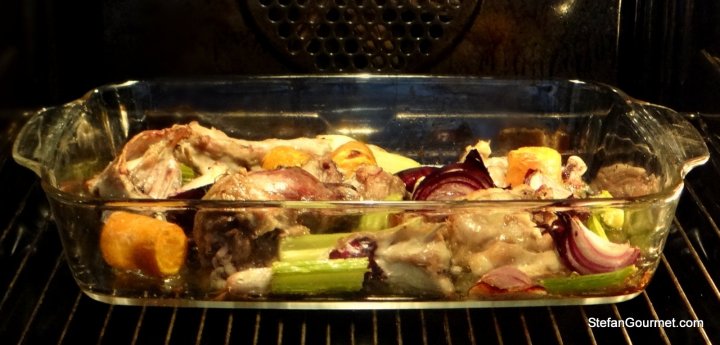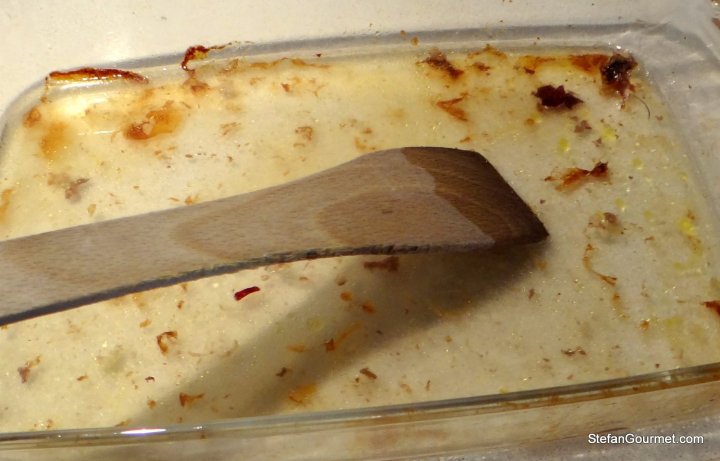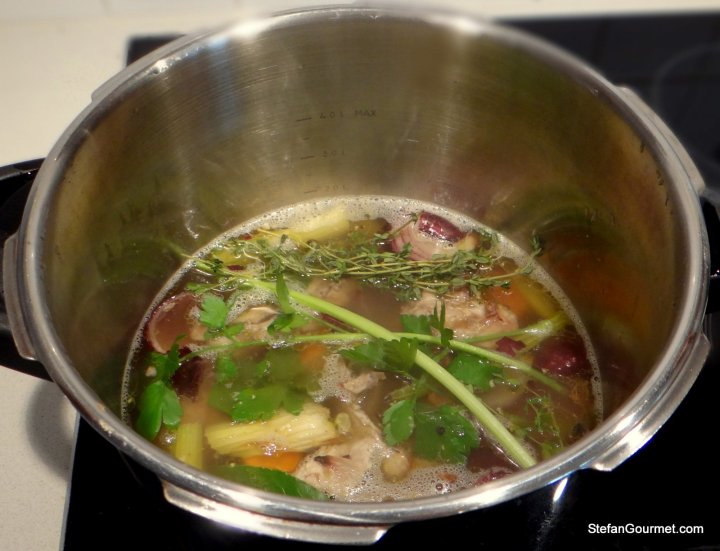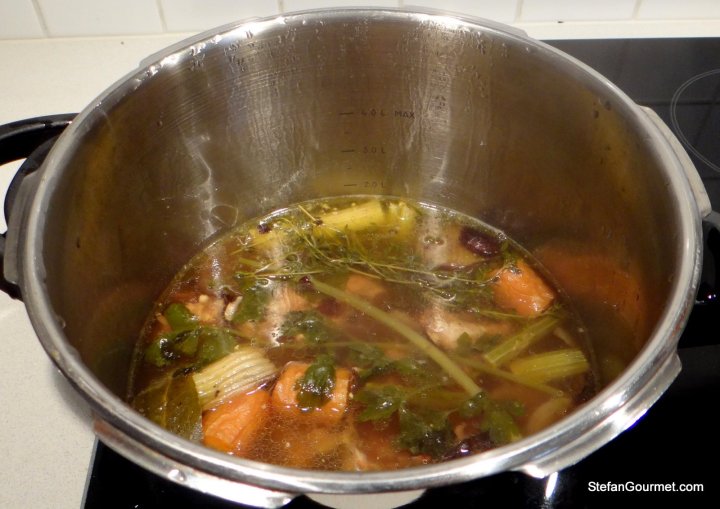It always surprises me when a lamb recipe uses beef stock for the sauce, or when a veal recipe uses chicken stock for the sauce, or… well I guess you catch my drift. Of course such substitutions can be made when the ‘proper’ stock is not readily available, but I believe that to get a lamb dish that tastes of lamb, or a veal dish that tastes of veal, it is best to use stock made from meat and bones of the same animal. And the same goes for rabbit. Another good reason for making rabbit stock is that when you buy a whole rabbit, there are parts that you otherwise wouldn’t use. At least, I don’t personally have a craving for deep-fried rabbit head. But that rabbit head (included also for showing that it is actually a rabbit and not a cat; for the same reason in many countries rabbits are sold with their furry feet still attached) and other leftovers from the whole rabbit are perfect for making stock.

And so here is my recipe for rabbit stock, which closely resembles my recipe for brown chicken stock. You can make it with a pressure cooker or without. Never add salt to a stock before you have reduced it to the desired thickness. You can always add salt later, but once it is in, you can’t get it out anymore. Like all stocks, this recipe is very simple and much better than anything store-bought. Not that I have ever heard of store-bought rabbit stock…
Ingredients

leftover bones and meat from 1 rabbit (loins, legs, and flap meat used for other recipes)
1 carrot
1 celery stick
1 onion
some fresh thyme
some fresh parsley
1 bay leave
some black pepper corns
a bit of olive oil
1 litre/quart of water
Preparation

Preheat the oven to 190C/375F (forced air). Roughly chop the rabbit and vegetables. Put all in an oven proof dish, and toss with some olive oil until lighted coated on all sides. The layer of oil is important to get some good browning.

Roast at 190C/375F for half an hour or until nicely browned.

Transfer the contents of the oven dish to a stock pot or pressure cooker. Deglaze the oven dish with part of the water.

Use a spatula to include all of the browned tasty bits. Add this water and the remaining water to the stock pot.

If using a pressure cooker, add the parsley, thyme, bay leaf and pepper corns. Close the pressure cooker, pressurize over high heat, reduce the heat, and cook for 1 hour and 30 minutes.
If not using a pressure cooker, bring the water to a boil first. Remove the scum that will rise to the surface with a slotted spoon. Then add the parsley, thyme, bay leaf and pepper corns (you would have regretted adding them before removing the scum, especially the pepper corns). Reduce the heat and cook, covered, for 3 hours.

If using a pressure cooker, you can either wait for it to cool off at the end of cooking or run cold water over the pressure cooker to make this go more quickly.

Sieve the solids out of the stock.

If desired, reduce the stock over medium low heat by simmering it. When tasting the stock, take into account that it has not been salted yet.

The easiest way to remove the fat is to allow the stock to cool to room temperature and then refrigerate it. The fat will become a solid layer on top that you can easily remove. As rabbit is usually very lean, most of this fat will be the olive oil you added for the roasting and there is thus not much use for this fat.


I think that if I did this, I would end up with the rabbit stock in the freezer for a couple of years. I don’t eat rabbit very often. I do like it a lot though.
LikeLike
Is that because of females at your dinner table having qualms about eating cute furry animals? 😉
LikeLike
You got it.
LikeLike
So smart to do this!
LikeLike
🙂
LikeLike
I love that you utilized the whole rabbit and did not allow those delicious leftovers to go to waste. The stock’s flavors look awesome!
LikeLike
Thanks, Shanna. I always try to squeeze all of the flavor out of the ingredients I use 🙂
LikeLike
Admirable. The sensibilities of a true chef.
LikeLike
Although I’ve seen rabbits with feet attached, those that I purchase are head and foot-less, which is fine with me. Like Conor, I haven’t much use for rabbit stock, though I’m sure yours is a good one, Stefan. 🙂
LikeLike
Love it. I just can’t throw bones away. My kids always laugh because I’m always making stock and keep gallons in the freezer for soups, stews, braises, sauces, etc. Of course, they never complain about the soups, stews, braises, etc. Like they say, waste not want not.
LikeLike
Unfortunately I have a very small freezer, because it would be handy to make stocks in big batches and freeze them. Soups, stews, braises and sauces are so much better when made with homemade stock.
LikeLike
You’re a very conscientious chef, so few people cook their stocks on their own…My respects!
LikeLiked by 1 person
Hey stefan,
What do you do with the solids that you sieve out? They looked appetizing in the photo.
LikeLike
I discard them, because most of the flavor is in the stock.
LikeLike